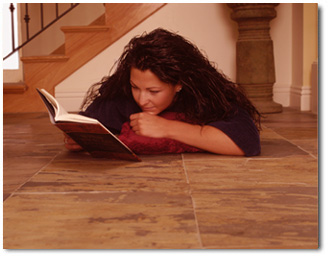
|
|

|

|
|
Radiant Heat
Radiant heat technology has been used by people for thousands of years; and with today's technological advancements, radiant heat is now an efficient home heating source used in homes and businesses throughout Europe and Northern America.
Heated floors utilize a heating element that radiates heat from the source, warming the closest and coldest objects to evenly warm the entire area. The warmth of radiant heated floors is something that must be experienced
to be fully appreciated. It provides a luxurious comfort and is very energy efficient.

Heated Driveways

Heated driveways utilize the same technology as floor warming systems. Electric snow melting systems are fully automated,
maintenance free, and energy efficient. A high-tech snow sensor activates the system only when temperature and precipication conditions warrant.

|
|
|

What Does Radiant Heat Feel Like?

The best way to describe radiant heat would be like the experience of walking along the beach on a sunny day and felting the warm sand underneath your feet.
Another good example of radiant heat is when hot coffee is poured into a mug, when then gets warm.
Even after the original heating source stops radiating heat, nearby objects maintain the warmth for awhile. Obviously, some materials retain the heat longer than others.
But the warmth from radiant heated floors is gentle, luxurious and efficient.
How Electric Radiant Heating Systems Work

When a radiant heating system is activated, electrical current is forced through the conductive heating material (heating element). For line voltage radiant heat systems,
(110V) of electricity is forced through the heating cable. Low-voltage
systems utilize a step-down transformer (within the master controller) to convert the line voltage to low voltage (8-30V).
 and this low
current is then forced through the heating element. Line voltage and low-voltage systems
are equally efficient.
FloorHeat features a
unique low-voltage, self-regulating heating element that extremely then, so no floor
build-up is required. FilmHeat is also "paper thin" and can be used directly under the flooring or stapled up between the floor joists from below. and this low
current is then forced through the heating element. Line voltage and low-voltage systems
are equally efficient.
FloorHeat features a
unique low-voltage, self-regulating heating element that extremely then, so no floor
build-up is required. FilmHeat is also "paper thin" and can be used directly under the flooring or stapled up between the floor joists from below.

The heated material then heats the flooring until it reaches the right temperature set by the floor
thermostat.
The radiant heat then passes through the floor and continues to heat other objects in the room (tables, chairs, people). The heat will continue
to heat the room and its objects up to the ceiling. Radiant heat will give you the most consistent room temperature from floor to ceiling compared
to any other heating system.

To learn more about the effectiveness of radiant heat and how it warms a room compared to a forced air or gas heating system, click on
Radiant Heat vs. Forced Air.
|
|
|

|



